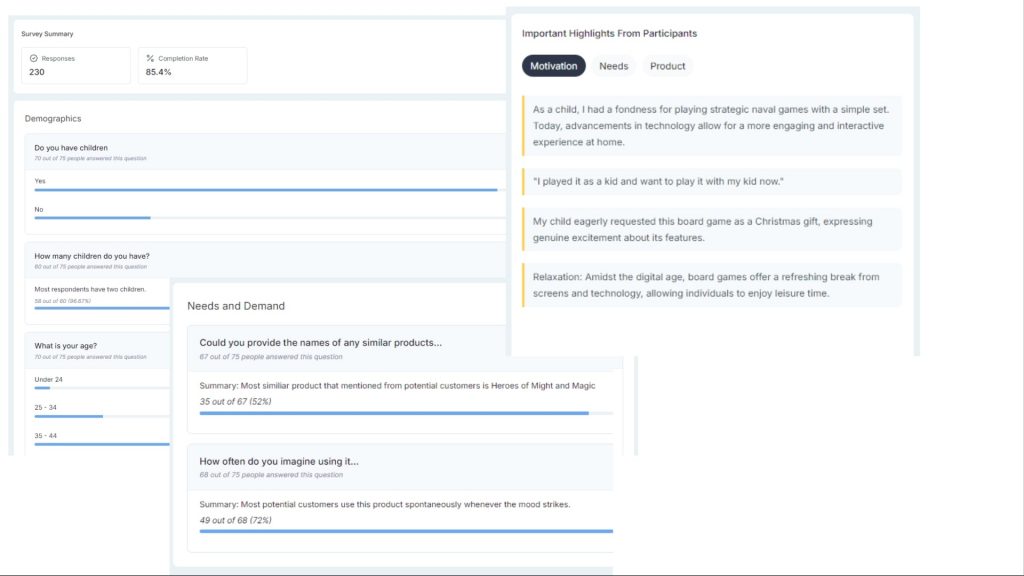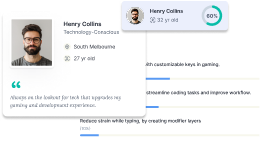In today’s competitive market, launching a product without fanfare is a scenario every entrepreneur, product manager, and business owner strives to avoid. The key to preventing this outcome? Consumer research.
This guide offers a comprehensive exploration of consumer psychology and market dynamics. It’s designed to provide you with actionable insights and strategies to:
- Uncover genuine customer needs and desires
- Identify the critical elements that contribute to product virality
- Develop a deeper understanding of consumer behavior
By mastering these techniques, you’ll be equipped to create products that resonate with your target audience, potentially disrupting markets and setting new trends.
Are you ready to elevate your approach to product development and marketing? Let’s delve into the world of consumer research and unlock its potential for your business success.
What Is Consumer Research?
Consumer research is the systematic collection and analysis of information about individuals or organizations that could use your product or service. It’s a critical component of market research that focuses specifically on understanding consumer behavior, preferences, and needs.
The primary goals of consumer research include:
- Identifying target markets
- Understanding consumer needs and wants
- Assessing the market potential for new products or services
- Evaluating consumer satisfaction with existing offerings
- Informing product development and marketing strategies
By conducting thorough consumer research, businesses can make data-driven decisions, reduce the risk of product failure, and increase their chances of success in the marketplace.
The Consumer Research Process
A well-structured consumer research process is crucial for obtaining actionable insights. Let’s break down each step in greater detail:
Step 1: Define Your Research Objectives
Start by clearly articulating what you want to learn. Your objectives should be SMART: Specific, Measurable, Achievable, Relevant, and Time-bound. For example:
- “Determine the top 3 features our target market values in a productivity app within the next 30 days”
- “Identify price sensitivity for our new eco-friendly cleaning product among urban millennials by Q3”
Having clear objectives will guide your entire research process and ensure you’re gathering relevant data.
Step 2: Identify Your Target Audience
This step involves creating detailed buyer personas that represent your ideal customers. Consider:
- Demographics: Age, gender, income, education, occupation
- Psychographics: Values, interests, lifestyle, personality traits
- Behaviors: Purchasing habits, brand preferences, online activity
- Pain points: Challenges and problems they face
Pro tip: Leverage Prelaunch.com’s Customer Insights tool to gain data-driven insights into your target audience. This platform can help you identify key characteristics and preferences, ensuring your research is focused and effective.
Step 3: Choose Your Research Methods
Select methods that align with your objectives and target audience. Consider a mix of:
- Quantitative methods: Surveys, experiments, data analysis
- Qualitative methods: Interviews, focus groups, observational studies
Factor in your budget, timeline, and required sample size when choosing methods. (Scroll down to the Consumer Research Methods for a list of specific tools.)
Step 4: Design Your Research Instruments
Create your research tools, such as:
- Survey questionnaires
- Interview guides
- Observation checklists
- Experimental protocols
Ensure questions are clear, unbiased, and directly related to your objectives.Pro tip: Creating your own research tools is easier said than done. To consolidate your efforts consider using platforms like Prelaunch that already have embedded surveys, in-depth interviews, and analytics set up as part of the concept validation process.

Step 5: Collect Data
Implement your chosen research methods. Ensure you’re:
- Reaching a representative sample
- Following ethical guidelines
- Maintaining consistency in data collection procedures
Step 6: Analyze and Interpret the Data
Go beyond surface-level findings:
- Use appropriate statistical techniques for quantitative data
- Conduct thematic analysis for qualitative data
- Look for patterns, trends, and correlations
- Consider the context and limitations of your data
Step 7: Draw Conclusions and Make Recommendations
Based on your analysis:
- Address each of your initial research objectives
- Identify key insights and their implications for your business
- Develop actionable recommendations for product development, marketing, or strategy
Step 8: Implement and Monitor
Put your findings into action:
- Create an implementation plan with specific actions and timelines
- Assign responsibilities for each action item
- Set up metrics to monitor the impact of your changes
- Plan for follow-up research to assess the effectiveness of your implementations
Remember, consumer research is an ongoing process. Regularly revisit and update your research to stay ahead of changing consumer preferences and market trends.
Consumer Research Methods
There are numerous methods for conducting consumer research, each with its own strengths and weaknesses. Here are some of the most common and effective techniques:
- Surveys: Online or in-person questionnaires that gather quantitative data from a large number of respondents.
Tool: SurveyMonkey – An online platform for creating, distributing, and analyzing surveys, offering robust tools to gather quantitative data from a large number of respondents.
- Focus Groups: Moderated discussions with small groups of consumers to gather qualitative insights.
Tool: FocusVision – A platform that provides tools for conducting online or in-person focus groups, allowing moderators to gather qualitative insights from small consumer groups.
- Interviews: One-on-one conversations with consumers to gain in-depth understanding of their thoughts and behaviors.
Tool: UserTesting – A platform that connects researchers with consumers for one-on-one interviews, helping businesses gain in-depth understanding of consumer thoughts and behaviors.
- Observational Research: Watching consumers interact with products in real-world settings to understand their behavior.
Tool: Dscout – A research platform that enables researchers to observe consumers in their natural environments, capturing real-world behaviors through mobile ethnography and video diaries.
- Social Media Listening: Monitoring online conversations about your brand or product category to understand consumer sentiment.
Tool: Brandwatch – A powerful social media listening tool that monitors online conversations across various platforms to understand consumer sentiment and trends related to your brand or product category.
- A/B Testing: Comparing two versions of a product or marketing message to see which performs better with consumers.
Tool: Optimizely – A leading platform for A/B testing, allowing businesses to compare two versions of a product or marketing message to determine which performs better with consumers.
- Ethnographic Research: Immersing researchers in the daily lives of consumers to gain deep insights into their behaviors and needs.
Platform: Research for Good – A platform that supports ethnographic research by connecting researchers with consumers, enabling deep immersion in consumers’ daily lives to uncover behaviors and needs.
- Big Data Analysis: Analyzing large sets of consumer data to identify patterns and trends.
Tool: Tableau – A data visualization and analytics platform that helps researchers analyze large sets of consumer data to identify patterns and trends, driving informed decisions.
- Concept Testing: Presenting potential product ideas to consumers to gauge interest and gather feedback.
Tool: Prelaunch – A platform offering tools for concept testing, allowing businesses to present potential product ideas to consumers and gather feedback to gauge interest.
- Usability Testing: Observing how consumers interact with a product or interface to identify areas for improvement.
UsabilityHub: A platform that enables researchers to conduct usability tests, observing how consumers interact with products or interfaces to identify areas for improvement.
The choice of method depends on your research objectives, budget, timeline, and the type of information you need to gather. One more thing to consider is that wrangling several tools for conducting primary market research can be tough. So can pooling all your data together in one place. Looking for a life hack on this? Try Prelaunch – a one-stop-shopping concept validating platform that is set up to track your prospective customers, interact and gain cutting-edge insight from them via surveys, focus groups, and in-depth one-on-one interviews.
Common Mistakes in Consumer Research
Avoiding these pitfalls can significantly improve the quality and usefulness of your consumer research.
1. Confirmation Bias
What it is: Seeking out information that confirms pre-existing beliefs while ignoring contradictory evidence.
How to avoid it:
- Actively look for data that challenges your assumptions
- Involve team members with diverse perspectives in the research process
- Use blind analysis techniques when possible
2. Leading Questions
What it is: Phrasing questions in a way that influences respondents’ answers. This is something you may need to be warry of when it comes to open-ended questions.
How to avoid it:
- Use neutral language in your questions
- Have multiple people review your research instruments
- Conduct pilot tests to identify potentially biased questions
3. Insufficient Sample Size
What it is: Drawing conclusions from too small a group of consumers.
How to avoid it:
- Use sample size calculators to determine the appropriate number of respondents
- Consider statistical power when planning your research
- Be cautious about generalizing findings from small samples
4. Ignoring Qualitative Data
What it is: Focusing solely on numbers and neglecting valuable consumer insights and opinions.
How to avoid it:
- Use mixed-method approaches that combine quantitative and qualitative research
- Allocate sufficient time and resources for qualitative analysis
- Use qualitative insights to add context and depth to quantitative findings
5. Misinterpreting Data
What it is: Drawing incorrect conclusions due to lack of context or misunderstanding of statistical significance.
How to avoid it:
- Invest in proper statistical training for your team
- Consult with data experts when dealing with complex analyses
- Always consider practical significance alongside statistical significance
6. Neglecting Secondary Research
What it is: Failing to review existing research and data before conducting primary research.
How to avoid it:
- Conduct a thorough literature review before starting your research
- Utilize industry reports, academic studies, and publicly available data
- Use secondary research to inform your primary research design
7. Poor Timing
What it is: Conducting research at times when consumers are likely to be biased or unrepresentative.
How to avoid it:
- Consider seasonal effects on your product or industry
- Avoid conducting research during major events that might skew results
- If timing is an issue, acknowledge it as a limitation in your findings
8. Overlooking Cultural Differences
What it is: Applying research findings from one market to another without considering cultural nuances.
How to avoid it:
- Conduct separate research for different cultural markets
- Use local experts or partners when researching unfamiliar cultures
- Be aware of how cultural differences might impact survey responses or behaviors
9. Asking the Wrong Questions
What it is: Failing to align research questions with business objectives.
How to avoid it:
- Clearly define your research objectives before designing your study
- Regularly refer back to your objectives throughout the research process
- Ensure each question in your research directly relates to your objectives
10. Not Acting on Findings
What it is: Conducting research but failing to implement the insights gained.
How to avoid it:
- Develop an action plan as part of your research process
- Assign ownership for implementing key findings
- Set up a system for tracking the impact of changes made based on research
By being aware of these common mistakes and taking proactive steps to avoid them, you can significantly enhance the quality and effectiveness of your consumer research efforts.
Examples of Successful Consumer Research
Let’s look at some real-life examples of companies that have leveraged consumer research to achieve remarkable success:
Lego
In the early 2000s, Lego was on the brink of bankruptcy. Through extensive ethnographic research, observing how children played with their products, they discovered that kids valued mastery and the challenge of building complex structures. This led to the development of more intricate sets and product lines aimed at different age groups and skill levels, contributing to Lego’s remarkable turnaround.
Procter & Gamble (Febreze)
P&G’s air freshener Febreze was initially a market failure. Through in-depth consumer research, including in-home observation, they discovered that people became desensitized to bad smells in their homes. This insight led to a complete reposition of the product as a “finishing touch” to cleaning, rather than an odor eliminator. The new approach resonated with consumers and turned Febreze into a billion-dollar brand.
Starbucks
Starbucks consistently uses consumer research to inform its product development and customer experience strategies. Their mobile app, which allows for easy ordering and payment, was developed based on extensive customer feedback and usability testing. This consumer-centric approach has helped Starbucks maintain its position as a leader in the competitive coffee market.
These examples demonstrate the power of well-executed consumer research in driving business success across various industries.
Conclusion
Consumer research is a vital process that can significantly impact your product’s market success. Understanding your audience, employing the right strategies, and learning from success stories can all provide critical insights for growth. It is crucial to continually update your consumer research as markets and consumer preferences change. Mastery of consumer research is a powerful tool for informed decision-making, product development, and business success. By using tools like Prelaunch and the guidelines in this guide, you’re ready to harness consumer research for your upcoming product release.




